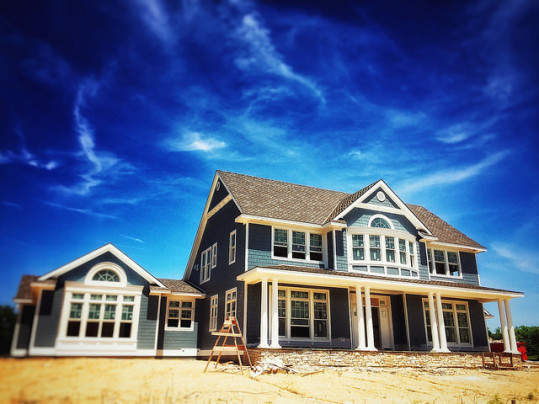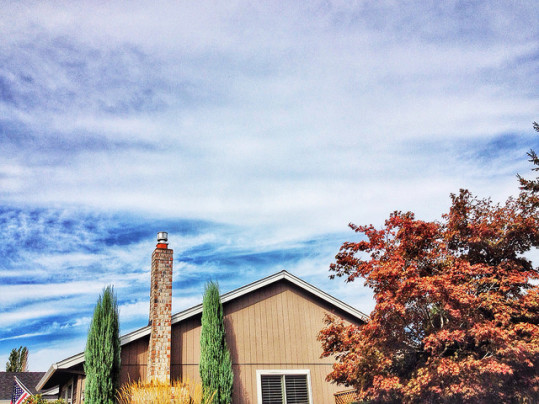In 2015, the median size of a completed single-family home was 2,467 square feet, according to new numbers from the U.S. Census Bureau’s annual Characteristics of New Housing. That’s 61 percent larger than it was 40 years ago and 11 percent bigger than a decade ago. And, in addition to the extra square footage, today’s new homes are also packed with more features than they used to have. For example, more than 90 percent of new homes built last year had air conditioning and at least two bathrooms. By comparison, a little less than half of the new homes built in 1975 had air conditioning and only 60 percent of them had two bathrooms. But along with becoming bigger, new homes have also climbed in price. In fact, the median sales price of new single-family homes sold last year was $296,400. That sets a new record and partly explains the reason why first-time home buyers have had difficulty finding affordable homes this spring. With the average new home selling for around $300,000, buyers looking for an affordable, starter home in many markets are limited to choosing from previously owned homes – as the majority of new homes are priced beyond their budget. Also in the report, among new homes built last year, 47 percent had four or more bedrooms, more than half were two stories, and a majority had two-car garages. More here.
Archive for June 2016
Home Loan Demand Spikes As Buyers Return
According to the Mortgage Bankers Association’s Weekly Applications Survey, mortgage application demand bounced back from a big drop two weeks ago, surging 9.3 percent last week. The increase included a 7 percent gain in refinance activity and a 12 percent spike in the number of Americans requesting applications for loans to buy homes. Still, industry analysts say demand for home purchase applications should be stronger considering the high level of buyer interest and mortgage rates that remain historically low. Last week, the average contract interest rate for 30-year fixed-rate mortgages with conforming loan balances fell slightly. At the same time, average rates were up for loans backed by the Federal Housing Administration and unchanged for mortgages with jumbo balances. Michael Fratantoni, MBA’s chief economist, told CNBC that despite expectations that the Fed would raise rates this month, May’s week jobs report may change that. “Given the weak employment report for May, we think it is unlikely that the Fed will raise rates in June,” Fratantoni said. “However, as other economic data are pointing to continued economic growth, we do expect that they will increase rates following their July meeting.” For now, though, average mortgage rates remain near three-year lows and are lower than they were at the same time last year. The MBA’s weekly survey has been conducted since 1990 and covers 75 percent of all retail residential mortgage applications. More here.
Rising Incomes Help Hopeful Home Buyers
The current housing market is a mixed bag. On the one hand, mortgage rates remain near record lows. At the same time, home price increases are causing affordability concerns. Additionally, home buyer demand is high but the number of homes available for sale is low. Because of this, recent results of Fannie Mae’s monthly Home Purchase Sentiment Index have been volatile. In March, sentiment hit an 18-month low. Then, according to the most recent release, it reached an all-time survey high in May. Partly, the increase in optimism was due to a 7 percent jump in the number of Americans who said their income was significantly higher than it was a year ago. Doug Duncan, Fannie Mae’s senior vice president and chief economist, says rising incomes and low mortgage rates could help home buyers facing higher prices and fewer choices. “Continued home price appreciation has been squeezing housing affordability, driving a two-year downward trend in the share of consumers who think it’s a good time to buy a home,” Duncan said. “The current low mortgage rate environment has helped ease this pressure, and fewer than half of consumers expect rates to go up in the next year. While the May increase in income growth perceptions could provide further support to prospective home buyers as the spring/summer home buying season gains momentum, the effect may be muted by May’s discouraging jobs report.” More here.
Competition Climbs Among Buyers’ Worries
A new survey of home buyers found the number who say their main concern is competition has nearly doubled since last November, rising from 11 to 19 percent in just seven months. But despite how quickly competition has emerged among buyers’ worries, it still trails affordability – which topped the list at 26 percent. Still, a lower-than-usual number of homes available for sale and high buyer demand means competition is increasingly a problem for home shoppers – and especially those on a budget. A bidding war can put buyers in the position of having to decide whether to break their budget or lose their chosen house. And the issue is especially pronounced on the lower end of the market where many first-time home buyers are searching for a starter home and a way out of high rents. “Though enticed by high rents and low mortgage rates to begin a home search, first-time buyers face a number of obstacles in today’s competitive market,” said Nela Richardson, chief economist for Redfin, who conducted the survey. “In many cities, starter homes have seen the largest price increases because the supply of affordable homes on the market is so low and the demand for these homes is so high.” Fortunately, the spring and summer sales season usually entices more current homeowners to put their homes up for sale, which could provide buyers some needed relief in the coming months. More here.
Could A Lack Of Lots Be Driving Prices Up?
When thinking of buying a home, few buyers consider the number of buildable lots in their area. However, builders say a shortage of available lots is keeping them from putting up more new homes. And at a time when the number of homes available for sale is already low, that isn’t good for buyers. That’s because, more new homes on the market would help slow down price increases, improve affordability, and provide buyers with more choices. According to a recent survey conducted by the National Association of Home Builders, 64 percent of builders say the supply of lots in their market is “low” or “very low.” That’s the highest it’s been since the NAHB began tracking lot availability in 1997. Robert Dietz, NAHB’s chief economist, says the problem is growing. “We have monitored lot availability for the last two decades, and it is clear that the scarcity of building lots is growing,” Dietz said. “Whether due to land use policy, geographic constraints or other regulatory constraints, the lack of lots for residential construction will have negative impacts on housing affordability in many markets.” Regionally, the West had the highest number of builders reporting a low number of lots, at nearly 40 percent. In the South, 23 percent of builders said lot supply was low, compared to 18 percent in both the Midwest and Northeast. More here.
Homeownership Month Promotes Benefits Of Buying
Since the financial crisis and housing crash, the real estate market has made a lot of progress. The job market has improved, millions of mortgage modifications helped struggling homeowners keep their homes, home prices have recovered, and interest rates remain near record lows. As part of National Homeownership Month, the Department of Housing and Urban Development hopes to – not only reflect on that progress – but also promote the benefits of owning a home. “A home is the place where we raise our children, establish roots in a community, and plan our future,” HUD secretary Julian Castro said. “The opportunity to be a homeowner should be open to those ready and able to buy a home. As the housing market continues its recovery we must ensure that responsible homeowners have access to credit to make their dreams of homeownership a reality.” Despite the fact that homeownership continually ranks among Americans’ top goals and is still thought of as a vital part of achieving the American Dream, the nation’s homeownership rate is 63.5 percent – just above a 48-year low and well below its 2004 peak of nearly 70 percent. Still, strong buyer demand this spring is further evidence that, given the opportunity, most Americans want to become homeowners. More here.
Mortgage Rates Mixed As Demand Falls
According to the Mortgage Bankers Association’s Weekly Applications Survey, demand for mortgage applications fell last week, dropping 4.1 percent from the week before. The decline included a 4 percent decrease in the refinance index and a 5 percent drop in demand for applications for loans to buy homes. Still, purchase application demand is 28 percent higher than the same week last year and mortgage rates remain near historic lows. Michael Fratantoni, MBA’s chief economist, told CNBC that some of the volatility in the mortgage market is due to uncertainty about whether or not the Fed will raise interest rates this month. “Market expectations for a June Fed hike have increased recently leading to a flattening of the yield curve, as short-term rates have risen more than longer-term rates,” Fratantoni said. “As a result, we saw an increase in rates for 15-year mortgages last week, even as rates on 30-year loans remained unchanged.” In fact, average mortgage rates fell for both 30-year fixed-rate mortgages with jumbo balances and loans backed by the Federal Housing Administration. On the other hand, rates for 30-year loans with conforming balances were unchanged from the week before and 15-year fixed-rate mortgages increased. The MBA’s weekly survey has been conducted since 1990 and covers 75 percent of all retail residential mortgage applications. More here.







